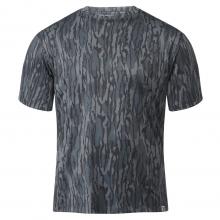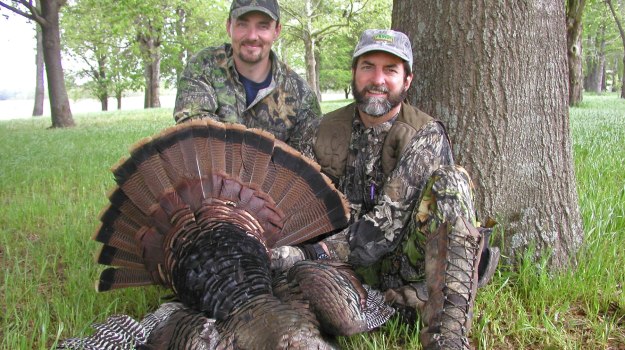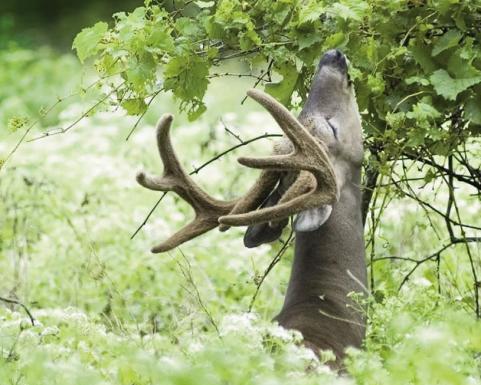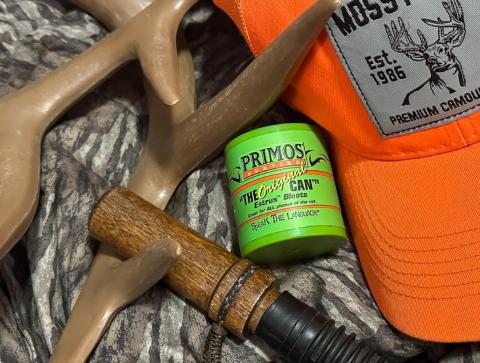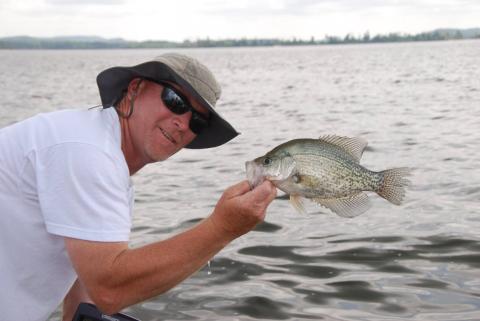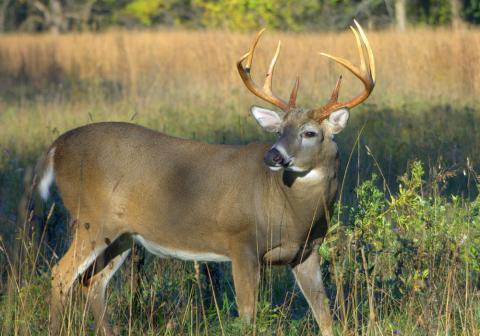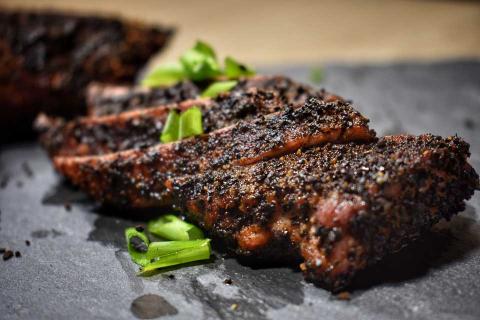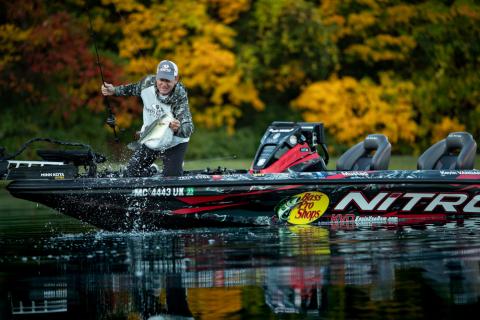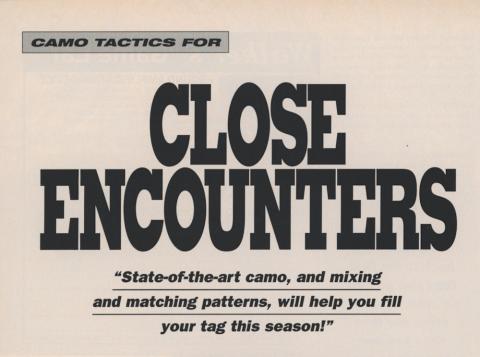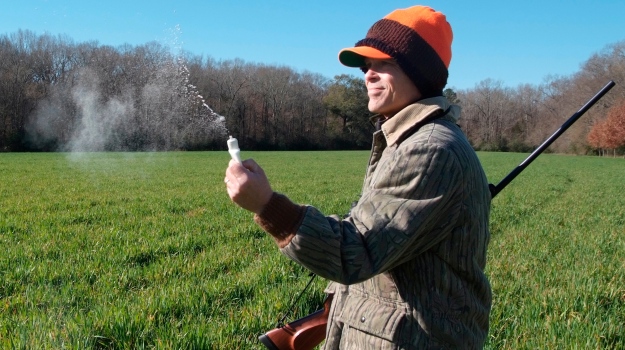
Tips to Reduce Pressure on your Herd & Improve the Hunting Experience
By Dave Edwards
It’s like clockwork. Each year around mid-December I begin receiving calls from frustrated hunters who are not seeing deer. I hear many different excuses such as, “We must have taken too many last season.” “Coyotes must be getting them.” “We had plenty of deer early in the fall, but our neighbors must be baiting them now.” “There are tracks everywhere so they must have gone nocturnal.” Justifications from the moon to weather patterns also arise. Once I give them time to vent their frustrations I need answers to a few questions like; how much rainfall have they received, what kind of acorn production did they have and how have they been hunting the property - because all of these things can dramatically effect deer movement.
In years of abundant rainfall and/or acorn production (like 2009 in some regions), deer movement, and thus deer sightings, are going to be lower due to the amount of natural foods available. With lots of food in the woods deer simply do not have to move far or venture out into open areas to meet their daily needs. This means less movement, fewer deer seen and overall tougher hunting. Regardless of how much food is available and despite what hunters want to believe, reduced deer movement and fewer sightings are quite often associated with how the property is hunted and the amount of hunting pressure being applied. That is, hunting strategies and pressure play a significant role in deer movement, the number of deer that are seen, and ultimately hunter success and satisfaction.
While hunting pressure affects the patterns of all deer, it is particularly evident in buck movement. As a consulting wildlife biologist who helps people across the Southeast, I see a similar scenario play out over and over. First, hunters recognize that they want to “grow bigger or better deer.” So they incorporate QDM strategies and begin to have some success, but after about three years they become frustrated because the mature bucks they have worked so hard to grow are not making it to the skinning shed. Generally speaking, “growing big bucks” is the easiest thing we do as biologists…getting them in front of hunters is the challenge.
As bucks mature they become more cautious. Research has shown they generally move less than young bucks, particularly during daylight hours. To see and harvest mature bucks hunters must hunt smarter and adjust their strategies. On properties that experience heavy hunting pressure, it is common for mature bucks (and other deer for that matter) to seem like they’ve “disappeared” once hunting season opens and hunter activity increases. By “disappear” I do not mean they pack their bags and leave; they simply become educated and learn how to avoid hunters. While the focus always seems to be on bucks, deer in general learn fast how to avoid hunters.
Addressing a “hunting pressure problem” with a client or hunting club has to be done delicately. Hunters are easily offended when you tell them they need to reduce hunting pressure if they want to improve their success. Some tune out of the conversation pretty quickly because the first thing that goes through their mind is “you’re telling me I have to hunt less” – which is something they do not want to hear. Where in fact, reducing hunting pressure does not necessarily mean that you have to hunt less, you simply need to hunt smarter. Once I explain this, they are all ears and are anxious to learn more about how to be a smart hunter.
Ways to Reduce Pressure
Understand how deer use your property
The first step in learning to hunt smart is to understand how deer use your property. Where and when do they bed, travel and feed? Analyzing how whitetails use a property will increase your success – period. However, knowing this will also help you hunt smarter. You’ll have less impact on the herd thereby reducing your hunting pressure and improving the quality of your hunts over time.
One of the best ways to understand how deer use a property is to study aerial maps and satellite images to determine logical bedding areas, feeding zones, and travel paths. I can’t tell you how many countless hours I’ve spent studying aerial photographs trying to figure out what the deer were doing and what I could do to cross paths with them. Once you have identified areas that hold promise you will need to get in the woods to confirm your speculations with some “ground zero” scouting.
In my experience the best time (and “smartest” time) to perform full-scale scouting missions is right after the hunting season ends. Deer have been exposed to a great deal of pressure over the hunting season they are using areas they are most comfortable in and where they feel safe. If you find these areas now, you will be one step ahead next season once the hunting pressure builds and deer seem to have “disappeared.”
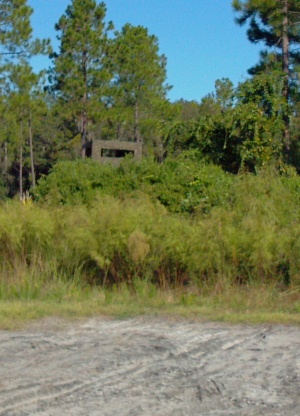 During this time of year the leaves are off the trees and buck sign is still fresh. Remember, your goal is to determine how deer are using the property so you can hunt smarter next season. As such, walk trails out to see where they go, be aware of potential food sources such as a large oak tree, honey suckle thicket, food plot or agriculture field. Pay attention to their direction of travel and look for potential hunting stand locations that will allow for undetected access and efficient scent management. Again, to reduce pressure and disturbance to deer, full scale scouting missions should not be done right before or during the hunting season, particularly on small properties.
During this time of year the leaves are off the trees and buck sign is still fresh. Remember, your goal is to determine how deer are using the property so you can hunt smarter next season. As such, walk trails out to see where they go, be aware of potential food sources such as a large oak tree, honey suckle thicket, food plot or agriculture field. Pay attention to their direction of travel and look for potential hunting stand locations that will allow for undetected access and efficient scent management. Again, to reduce pressure and disturbance to deer, full scale scouting missions should not be done right before or during the hunting season, particularly on small properties.
Keep in mind that how deer use a property can not only change from year to year as habitats change, but can change from month to month or even week to week during hunting season as habitat and food sources change.
Fly under the radar
Many factors should be considered when determining where a deer stand should be placed. Obviously, the location should conceal the hunter and provide relatively easy shooting opportunities. However, there’s more to it than making sure you are hidden. Besides concealment, important things to consider include; deer movement (i.e., where will the deer be coming from and where are they going?), where will the sun be during most hunts, site access, how will the topography or landscape effect wind direction, and which wind direction and thermal flow will you be able to hunt the stand.
Many hunters don’t realize the negative impact they have on deer movement simply by the way they enter or exit a stand. Most hunters feel that if they didn’t shoot or they aren’t “busted” while in the stand that they didn’t bother the deer. Nothing could be further from the truth. In fact, hunters spooking deer by sight or scent accounts for over 80% of the “we’re not seeing any deer” problems reported by hunters. When visiting a suspect property it is common to see hunting stands placed directly on food plots or over feeders (where baiting is legal). Hunters spook deer feeding on the plot or feeder each time they access or leave the stand. In some cases hunters even have to walk across a food plot to get in or out of a shooting house!
Getting to a stand is not usually as big of a problem as getting out because hunters generally enter the area before peak deer movements. However, climbing down and walking through a food plot full of deer right at dark has a significant impact! If this continues over the season, deer will enter the field later and later resulting in fewer deer seen by hunters during daylight. Westervelt collects thousands of hunter observations each year from our hunting clubs and clients. When analyzed, it is quite obvious when a club or client does a poor job with stand placement and/or wind management because fewer and fewer deer (particularly mature bucks) are reported with each consecutive hunt from a particular stand. Until they see this information on paper, some hunters just don’t understand the impact they are having on deer movement and tend to blame poor hunts on other things.
To minimize hunting pressure on food plots you must be very conscious about site access without impacting deer. At my hunting club, we try to locate every stand so a hunter could get in or out of a stand 30 minutes before dark with the food plot full of deer. Besides considering the wind direction, a key is to locate stands at least 20 yards off of the food plot’s edge and in the cover. To get hunters into and out of the stand, an access trail is needed. These trails allow hunters to step off of a main road or trail leading to the food plot to access the stand undetected.
To really fly under the radar, we often trim and rake out access trails that lead to a stand. This allows a hunter to walk silently on bare dirt. If existing vegetation in front of a stand does not provide adequate cover to conceal an approaching hunter, some type of screen is needed. By screen I mean something that will provide enough cover to hide hunters as they walk up to and enter a stand. Screens can be made of many things. We often plant a 20 ft. wide strip of Egyptian wheat, corn, or sorghum Sudan in the food plot along the edge where a stand is located. Switch grass or conifer trees make exceptional screens that don’t have to be planted each year. The goal is to provide something between the deer and the hunter to allow the hunter to go undetected.
Stands in the timber, such as a ladder stand in a hardwood hammock, are treated a bit differently. The primary considerations in placing these stands are wind direction and where deer are expected to be bedded, traveling or feeding. Access trails should be trimmed and noisy obstacles removed. Ideally, access trails can be raked to bare ground but this is not always an option. Stands in the woods generally do not require a screen, but concealment while in the stand is important. The lowest impact will be made by hunters who ensure the wind is not carrying their scent to where deer should be (such as bedding or feeding areas) and can slip in and out quietly.
Keep your head in the wind
As we all know, deer have an exceptional sense of smell. Once they smell the hint of danger the game is over. Manufacturers of deer scents and human odor eliminators have capitalized on this and it has become a multi-million dollar industry. The reason is simple – deer rely heavily on their sense of smell in every aspect of their life. If your scent is blowing towards an area that deer are using you have likely impacted them. In many cases you will never hear or see the deer you have affected.
I once bow-hunted a food plot with a friend where he sat on the opposite side from me. The wind was carrying his scent across the plot and to my left. As deer started to appear I saw a mature buck walking through the woods towards the plot. He was on a mission and walking rather briskly. When he hit my friends scent stream coming from across the plot, he hit the brakes, stood there for about 15 seconds with his nose in the air, then immediately and without hesitation turned around and silently walked right back where he came from. If I had not seen this buck, my friend would have never known the impact he had. That buck gained experience that he will use next time he visits the plot – which was probably under the cover of darkness! I often feel that deer smell us like we can smell a cigar. That’s probably how alarming human scent is to a deer.
Unfortunately, there are many hunters who think if they spray down with human odor remover and wear their “scent concealment suit” they don’t need to pay attention to the wind. Regardless of scent-free efforts, my experience has been that if a deer gets downwind chances are very high that it will detect me. This is not to say that these efforts are fruitless, in fact, just the opposite. I wash everything I own in scent-free detergent, wear rubber boots, often spray down with odor neutralizing sprays, and even wear carbon clothing when I can. Being as scent-free as possible will certainly reduce your chances of being detected, even by deer you don’t see, which helps keep overall hunting pressure being applied to a property to a minimum.
As it relates to reducing pressure, hunting an area with no regard to the wind is the quickest way to put deer on alert and reduce deer sightings. This is particularly true for stands on food plots. Always “hunt the wind.” By this I mean to always use the wind to your favor and try to remain upwind or crosswind whenever possible. I have been fortunate to have had the opportunity to work and hunt with some great hunters over the years. I mean the type of hunters you often see in magazines standing in front of a barn wall full of their trophies. Besides being great woodsmen and understanding deer, they all have a single common denominator – the wind dictates where they hunt and maybe more importantly where and when they don’t hunt.
One of the best ways I have found to assist in “scent management” and help minimize hunting pressure on a property is to create a “wind chart” for all stands to help make good decisions on where to hunt. This is simply a table that lists wind directions across the top (e.g., N, NW, NE, S, SW, etc) then lists the stand locations along the left column. In the row for each stand a checkmark is placed in each of the wind directions this stand can be hunted (see example). For example, if the wind was SW you would look down the column labeled SW for checkmarks, then choose one of the stands that could be hunted with a SW wind. A wind chart is very helpful for a hunting club with several members, particularly if some of the members are not experienced hunters. It is actually a rule at my club that members are not allowed to hunt a stand with the wrong wind direction – it’s that important.
Buddy Hunting
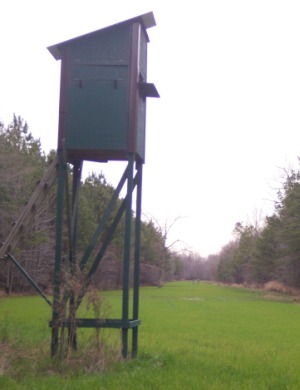 Invariably you will have some ambush sites that will not lend themselves to allowing hunters to get in and out of the stand undetected. If this is the case, the best way to hunt these stands is to “buddy hunt.” That is, only hunt these stands when you have someone else hunting with you that can pick you up at dark. Rather than climbing down from the stand and spooking deer, allow your partner to drive up to the food plot and spook the deer out of the area. Although this certainly impacts the deer and adds hunting pressure, they associate the negative event with the vehicle that pulled up not a hunter in the stand.
Invariably you will have some ambush sites that will not lend themselves to allowing hunters to get in and out of the stand undetected. If this is the case, the best way to hunt these stands is to “buddy hunt.” That is, only hunt these stands when you have someone else hunting with you that can pick you up at dark. Rather than climbing down from the stand and spooking deer, allow your partner to drive up to the food plot and spook the deer out of the area. Although this certainly impacts the deer and adds hunting pressure, they associate the negative event with the vehicle that pulled up not a hunter in the stand.
Three is a crowd
This will come at no surprise but hunting pressure increases as the number of people hunting the property increases. Even with the most cautious hunting strategies, more people simply add more pressure and ultimately result in fewer deer seen. I include this because I am often asked by hunting clubs “how many members they should have.” My answer is simple – “as few as you can afford.”
Have you ever hunted a popular public wildlife management area (WMA)? When I worked for the Florida Fish & Wildlife Commission I managed several public WMA’s. It was amazing how fast deer reacted to the intense pressure hunters put on them during opening weekend. On opening morning there would be shots ringing out every 5 minutes and hunters reporting lots of action and sightings. Although there were still plenty of deer left, by the next morning and over the following month few deer would be seen despite deer tracks everywhere and food plots being eaten down to the ground. This is an extreme case of applying hunting pressure and the effect of lots of hunters in the woods, but you get my point. It is also worth noting that a single hunter can overhunt a property and have a significant impact on deer sightings. However, as a rule of thumb, fewer hunters are better and will result in less pressure and better hunts.
Does and food plots
Harvesting an adequate number of does each year is essential to successfully manage a quality deer herd. Maintaining a desirable density and balancing the sex ratio promotes a healthy population and quality hunts. As such I am often asked my opinion regarding shooting does on food plots. My answer is always “it depends.” It depends upon your property’s dynamics, your goals and where you are in your management program. If you are just starting out and have an overpopulated herd that will require aggressive doe harvest to regain control, then my answer is - shoot does wherever the opportunity presents itself. Your goal at that point is to harvest deer, not worry about hunting quality. However, if your deer herd is in relatively good shape and you’re simply maintaining current standards, then do not kill does on your food plots. Shooting does on a food plot applies significant hunting pressure and will reduce deer sightings. The landscape on most properties offers plenty of places and opportunities to harvest does rather than on a food plot.
Sanctuaries
Sanctuaries are areas where no access or hunting is allowed to provide deer with a safe haven. Creating these areas will obviously eliminate hunting pressure on a portion of your property. With few exceptions like food plot management activities, human actions are off limits so as to provide a place for deer to relax with no stress. Deer learn about these areas quickly and will gravitate to sanctuaries once hunting pressure builds on surrounding areas. Establishing sanctuaries can be helpful in reducing hunting pressure and holding deer on small properties; say less than 1,000 acres, but they are particularly effective on properties less than 300 acres.
Obviously bigger is better, but sanctuaries are commonly 50-100 acres. I’ve even seen hunters on small properties not hunt at all during early season to completely avoid disturbance and pressure. As pressure from surrounding properties increased, deer would stack up on their small property. When they did start hunting, it was low impact and only on the edges maintaining sanctuary in the core of their property. I generally don’t even bring up the word “sanctuary” when working with a client unless the property is very small, being overhunted, or there are many people that hunt the property such as a large club. The reason is because most hunters are lazy and rarely walk/hunt far from a road. They are also creatures of habitat and generally hunt the same stands throughout the year. So most properties have several unofficial sanctuaries created just because no one ever ventures into them. I’m confident that if you think about the property you hunt, you can think of a few areas where no one ever goes.
To maximize the effectiveness of sanctuaries, hunters must use restraint and never enter the designated area. Hunting the edges, however, will generally result successful hunts if hunters apply low impact/smart strategies.
Conclusion
Although Mother Nature can be blamed for poor deer movement in some cases, reduced deer sightings and poor hunting is more often the result of high hunting pressure and deer learning to avoid hunters. Reducing hunting pressure takes effort, but is not hard to do and will significantly improve hunting experiences and success on your property. Keep in mind that reducing hunting pressure does not mean you have to hunt less, you simply need to hunt smarter. Hunting smart means that you pay attention to the wind, consider it when deciding which stand to hunt, create hunting setups that allow hunters to access and leave stands without disturbing deer, avoid disturbances on food plots and surrounding bedding cover, avoid full-scale scouting missions during the season, and set up or recognize “sanctuaries” on your property that will help reduce pressure and hold deer on your property, particularly as pressure builds on surrounding properties. Many of you have heard me say before that “great hunting doesn’t happen by accident.” I say this meaning that rarely does consistent great hunting happen without management of the habitat and herd. While you must have good habitat and a well managed deer herd to have great hunting, hunting pressure plays a significant role in just how “great” your hunting really is.






